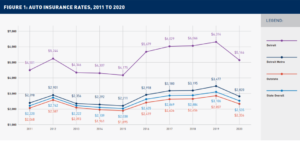Despite cost dip, Michigan auto insurance still high with persistent racial disparities

Contact: Lauren Slagter, 734-929-8027, lslag@umich.edu
Jared Wadley, 734-834-7719, jwadley@umich.edu
ANN ARBOR—Michigan’s auto insurance reform law has contributed to an 18% drop in average premium costs from 2019 to 2020—the steepest decline in the country over that time period, according to new analysis by Poverty Solutions at the University of Michigan.
However, Michigan still has the most expensive auto insurance in the U.S., and a 2019 law has failed to reduce disparities in cost by race and geography. A new policy brief, “Building on Michigan’s auto insurance reform law,” offers recommendations to further reduce premiums and address the unintended consequences of reform that led to some catastrophic accident victims losing access to medical care.
“The 2019 reform law was a first step, but lawmakers should not be content. More must be done to eliminate discriminatory rate-setting practices and further reduce premiums. We also need to consider the impact on people who have been catastrophically injured in auto accidents and ensure medical providers are appropriately reimbursed for long-term care,” said Amanda Nothaft, senior data and evaluation manager at U-M’s Poverty Solutions, who co-authored the policy brief with Patrick Cooney, assistant director of policy impact at Poverty Solutions.
Cooney also co-authored a March 2019 policy brief that examined the cost of auto insurance in Michigan as an economic mobility issue that prevented people across the state—and especially in Detroit, where average premiums are more than double the statewide average—from moving out of poverty.
That research informed the bipartisan auto insurance reform law passed in May 2019 that started to take effect in July 2020. Implemented policy changes recommended by Poverty Solutions included eliminating mandatory unlimited personal injury protection (PIP) coverage, restricting the use of non-driving factors like ZIP code and credit score to set auto insurance rates, and enforcing fee limits for medical care related to injury accidents covered by auto insurance.
The new analysis—based on data from The Zebra, an auto insurance comparison marketplace that collects rate information—shows the reforms have already lowered costs. Key findings include:
- Michigan’s average auto insurance rate fell from $3,106 in 2019 to $2,535 in 2020, an 18% drop that still left Michigan with the highest average auto insurance costs in the country.
- Auto insurance costs in Detroit saw the same rate of decline, from $6,314 in 2019 to $5,146 in 2020. Even with these reductions, average rates in Detroit still account for 18% of the median income in the city; the U.S. Department of Transportation defines auto insurance as affordable when it costs no more than 2% of a household’s income.
- Despite new restrictions on the use of non-driving factors to set rates, auto insurance costs are still highly correlated with race, more so than geography. Across Michigan, the average premium in 2019 for the 37 ZIP codes where the majority of residents are Black was $5,500, compared to $3,106 for the statewide average.
- The method used to cap medical fees may be unnecessarily stringent and out of line with national peers, causing a crisis in access to care for victims of catastrophic accidents that occurred prior to reform.

The policy brief also includes recommendations on how to further lower rates and ensure Michigan’s auto insurance system does stand as a barrier to economic mobility. While unlimited PIP coverage is no longer mandatory, Michigan is still an outlier in the amount of PIP drivers have to purchase. Offering more PIP coverage options would help reduce rates overall.
To address persistent racial disparities in auto insurance rates, the researchers recommend more regulation of the factors used to set rates by establishing mandatory driving-related factors that must carry a certain weight in the calculation. The 2019 reform prohibited the use of certain non-driving factors, but insurance companies can still use proxies for those factors—like “territories” instead of ZIP code and insurance scores that include a credit score component—that reinforce insurance redlining.
Another recommendation is to revisit reimbursement rates for medical procedures not on the Medicare fee schedule. Containing the medical costs for auto accident victims is key to reducing auto insurance costs, but the sharp reduction in reimbursement rates for certain services under the 2019 reform has forced some medical providers out of business and jeopardized access to long-term care for some catastrophic accident victims. Lawmakers could restructure the Catastrophic Claims Fund to support long-term care facilities and cover higher reimbursement rates.
“Michigan’s Catastrophic Claims Fund could play a much larger role in ensuring long-term support for people catastrophically injured in an auto accident,” Cooney said. “The 2019 auto insurance reform made meaningful changes that lowered rates for Michigan drivers. But there is much more to do. We need to acknowledge what’s working, and fix what’s not.“
